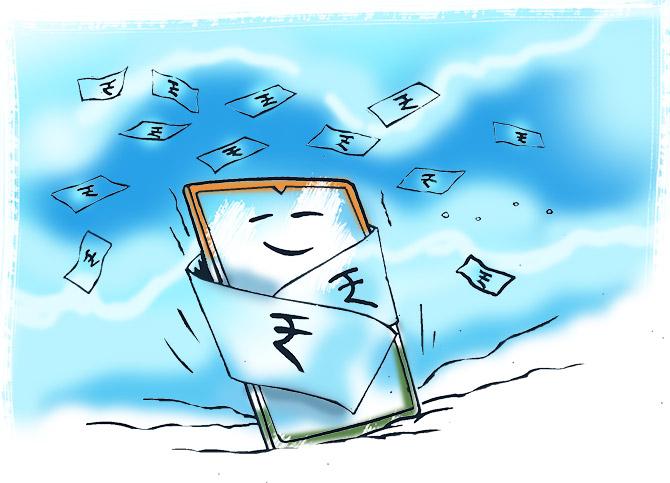'While consumers have benefited tremendously from rock-bottom telecom tariffs, the telecom sector has been reeling under deep financial stress,' points out Rajan S Mathews, director general, Cellular Operators Association of India.
Illustration: Dominic Xavier/Rediff.com

Hyper competition in the telecom sector over the past several years has caused a steep decline in average revenue per user (ARPU).
With rapid consolidation (the Indian market at one time had more than 10 operators, but now only four big players remain) and the resulting intensification of competition, ARPUs nosedived to record lows.
In fact, industry ARPU has declined by almost 48 per cent in the last 10 years -- from Rs 141 in 2009-2010 to Rs 73 in 2018-2019.
The absolute decline in ARPU is even starker if we consider inflation, which has been a constant companion of a developing economy such as India.
In spite of the fact that inflation has put pressure on telecom service providers's costs, the ARPU, after adjusting for inflation, has consistently declined over the last 10 years -- from Rs 125 in 2009-2010 to a mere Rs 69 in 2018-2019.
This is the lowest recorded ARPU in the country, even if we take the entire decade into consideration.
Thus, while consumers were spending higher amounts on daily necessities, their monthly telecom bills witnessed a deflationary trend.
If we look at another parameter, that of currency movements -- the value of the US dollar vis-a-vis the rupee -- the decline in ARPU is very significant.
Industry ARPU adjusted for appreciation in the value of the dollar plummeted by a whopping 66 per cent over the last 10 years.
The value of the dollar appreciated steeply, from Rs 44.83 to the dollar in 2009-2010 to Rs 69.17 in 2018-2019.
In fact, ARPU adjusted for appreciation in the value of the dollar plunged from $2.53 in 2010-2011 to $1.05 in 2018-2019.
Considering the fact that telcos pay for the equipment they purchase in dollar terms, the appreciation in the dollar on the one hand and the decline in revenue per subscriber on the other has been a double whammy, and has only added to the financial woes of the cash-strapped telecom sector.
Also, while the per capita income of consumers improved considerably over the last 10 years, thanks to the overall economic buoyancy and resilient business environment, ARPU as a proportion of per capita income declined from 3.6 per cent in 2009-2010 to a mere 0.69 per cent in 2018-2019.
This is the lowest it has plummeted in the past 10 years.

Thus, today's consumers are paying a trivial portion of their income for their communication needs, compared to what they used to pay just a decade ago.
Ironical as it may sound, the quality and speed of communication has improved by leaps and bounds in this period.
While consumers have benefited tremendously from rock-bottom telecom tariffs, the telecom sector has been reeling under deep financial stress.
The steep decline in ARPU over the years led to significantly squeezed margins, ballooning debt and falling revenues.
The double hit from the high spectrum cost and the revenue share levies, which include licence fees and spectrum usage charges, has created a scenario where telecom service providers were left with no choice, but to hike the existing tariff rates.
Even after the recent hike in tariffs, consumers will still be paying a paltry amount of 0.86 per cent of their per capita income, which is still much lower than what it was four years ago.
After meticulous analysis, many experts and industry stakeholders came to the conclusion that the hike in tariff by telecom operators will actually prove to be immensely beneficial to consumers, the government and the industry alike, in both the short as well as the long term.
As the earnings of the sector improve, so will the investments, which will ultimately result in better network infrastructure, and usher in new capabilities, innovations and technological advancements, thereby bringing about augmented quality of communication services for the consumers.
With the price hike, the government's share of revenue from the telecom sector will definitely improve in due course.
Telcos will also have some additional funds to invest in enhancing and expanding services to consumers, garner profits from newer channels of revenue that emerging technologies will bring with them and, ultimately, would also be able to fulfil the objectives that are outlined under the National Digital Communications Policy 2018, which replaced the National Telecom Policy 2012.
Considering that telecom is the very economic backbone of the country and one of the key fulcrums driving the government's digital India programme, its financial well-being cannot be compromised at any cost.












